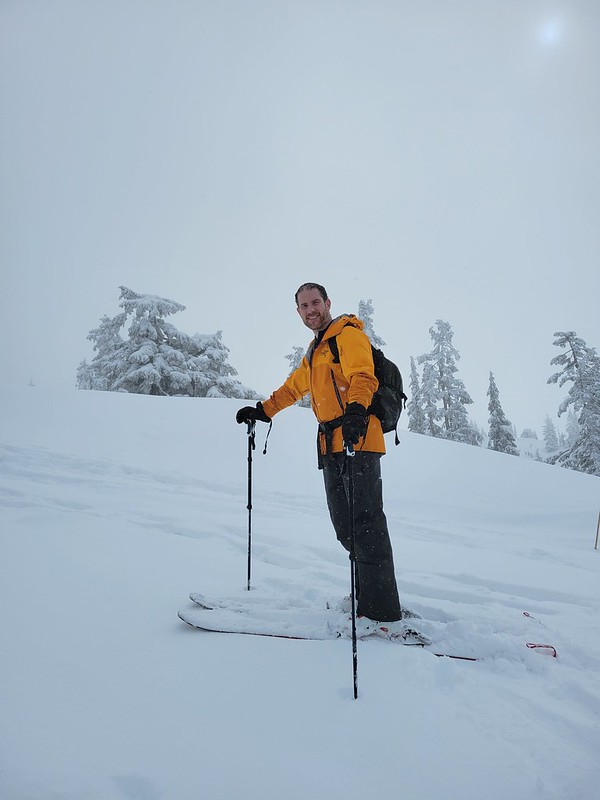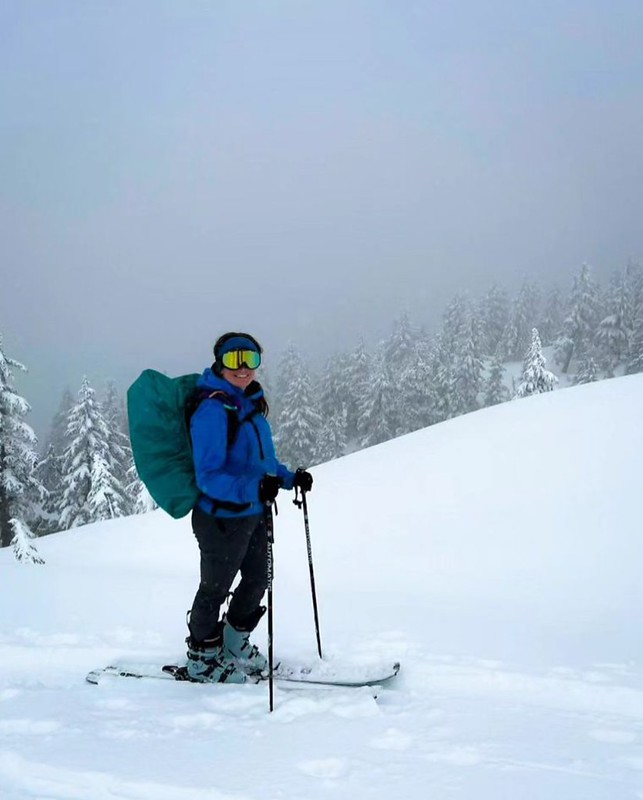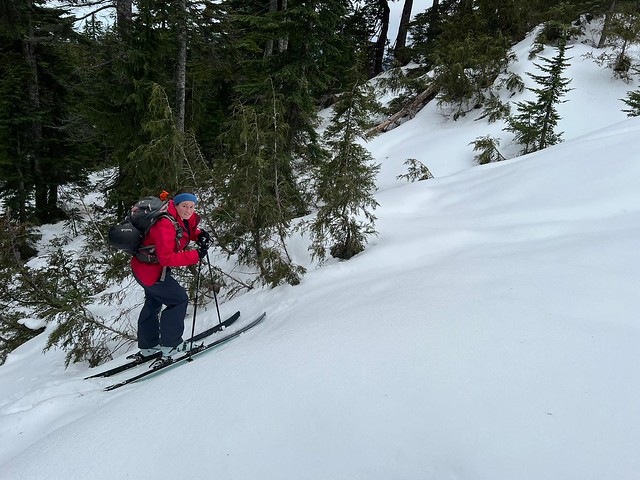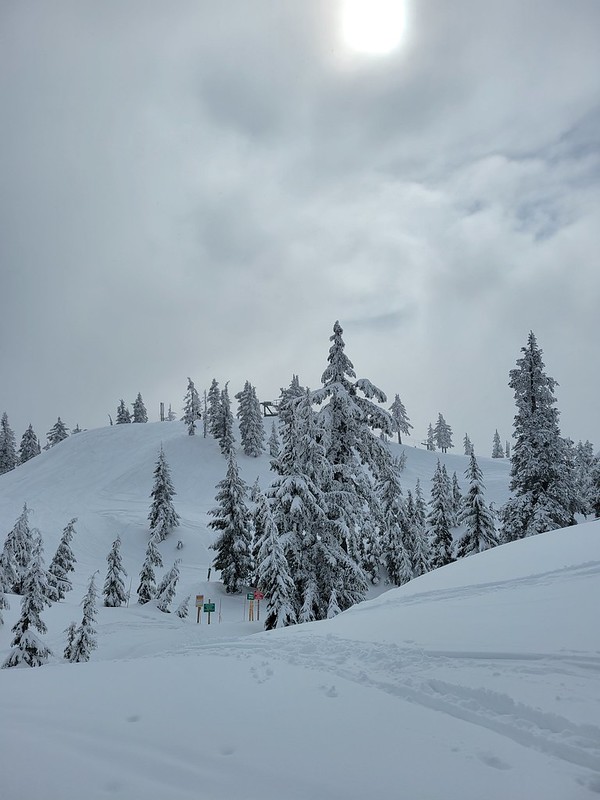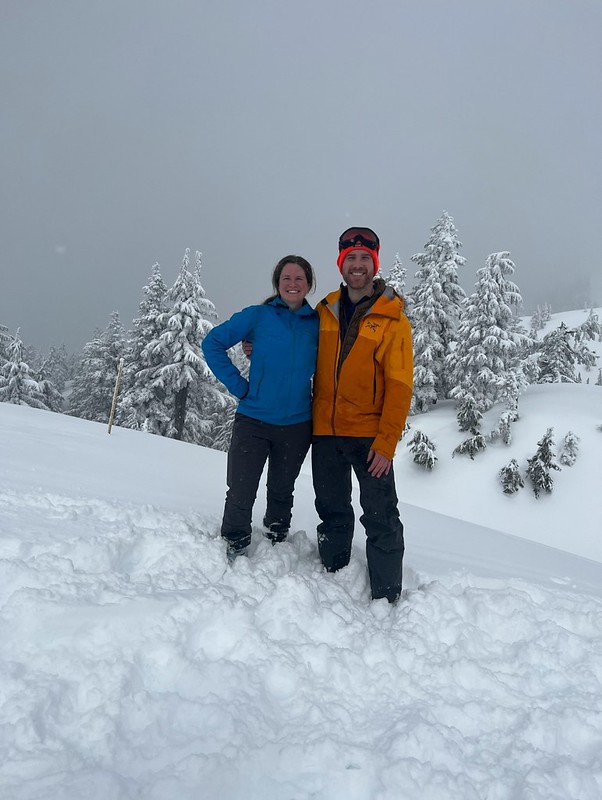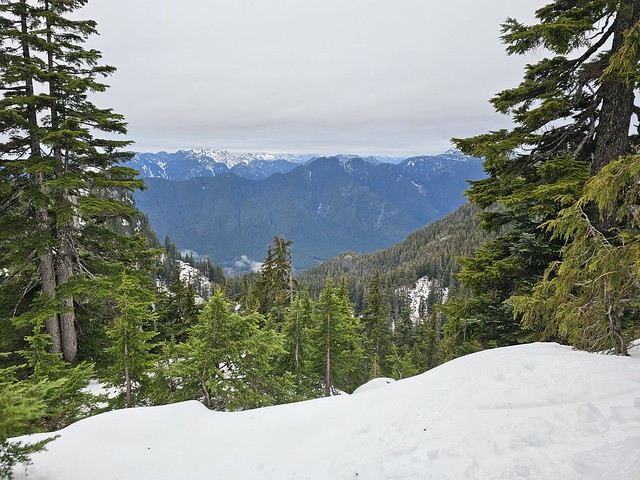I’ve been downhill skiing since I was 10 years old. Since moving to BC, it felt inevitable that I would eventually want to get into ski touring. It’s intrigued me for the past few years, but it’s such a high buy-in for new gear that I was reluctant to commit. My downhill skis are 16 years old and very narrow for west coast skis (68mm underfoot). Me and Carolyn both decided to get new downhill skis at the same time, and as soon as she said she was getting skis for touring, I was obligated to get them too!
For those of you unfamiliar with ski touring, to oversimplify it, it’s downhill skiing without a chair lift. Meaning you stick skins to the bottom of your skis that allow you to walk uphill. The bindings are also different and use a pin in the front that allows your heel to lift out of the binding while walking. They look a bit like what most people know as telemark skis. This allows you to explore a lot of different terrain that wouldn’t be accessible to ski otherwise. Once you get to the top of the hill, you take off the skins, switch your bindings from ‘walk’ to ‘ski’ mode, and clip in your heels for a more traditional downhill ski experience.
Choosing skis, bindings, and boots was a learning experience and took me most of last winter. A great tip when deciding is to take advantage of Whistler’s ski demo program. When you have your own equipment, you can demo skis for $20 a day, you just can’t keep any one pair of skis for more than 2 hours, but you can try different skis all day. I did this once at the demo shop on Blackcomb (at Rendez-Vous) and once on Whistler (at Roundhouse). You use your own boots and poles and it’s a good way to see what you like. My favourites were the Head Kore 97 skis, which I was able to get for a really good price online. It’s been an experience getting used to my new skis though since they are 30mm wider and 10cm longer than my previous pair.
Bindings were the most expensive part of my new gear, but the most straightforward. I wanted hybrid bindings that could be used both in the resort and in the backcountry (instead of the lightweight backcountry bindings). There’s really only one hybrid set on the market (called the lab shift) and they’re made by both Salomon and Atomic. For boots, I went to a professional boot fitter and tried on boots until I was happy. This was the most challenging part as I found a lot of them really uncomfortable. I opted for Salomon boots, but I’m not 100% sold on them yet.
Anyways, back to the point. After getting all my gear last year, the season as almost over, so I only got to ski tour once last year and opted to start with Brockton Point on Mount Seymour. It’s a popular trail for touring because there’s a dedicated trail up the mountain and you can ski down the resort runs. I was hoping to do lots of touring in 2023, but it’s been a terrible year for snow, so I kicked off my season with a second run up and down Brockton Peak as well. I’ve done it twice on skis now, both with my friend, Eddie.
Eddie has been ski touring for several years, so he’s been very tolerant and supportive while I get comfortable. I wasn’t quite sure what to expect, but overall I think it’s been easier than I anticipated. The downhill part is definitely scarier than the uphill part, but the uphill part has been surprisingly comfortable. It’s very easy to walk uphill with the skins on and to be honest, it’s a lot more comfortable than snowshoeing. Your weight is distributed more and because you’re sliding your feet versus lifting them, it’s a lot easier. There are some tricky parts when the trail is steep, but overall the uphill part has been pretty enjoyable. I think a lot of people imagine that it would be exhausting, but mentally you’re prepared to go uphill for an extended period of time, so it’s really more like hiking with a fun ski out. At this point, it’s not really about the downhill ski part for me. More experienced skiers are out there chasing fresh mountain powder, but since I’m learning, it’s less about that for me right now.
Anyways, Brockton Point is a great place to learn, because like I said, the downhill part is scarier than the uphill, but since you’re just skiing in the resort, it’s no different than a normal ski run, it’s just free. You just have to plan to get a day pass and park in the snowshoe lot since you’re not purchasing a resort pass. We followed the snowshoe trail up the side of the road and then up the side of the slope to Brockton. From Brockton, you can drop back onto the resort runs. It took us about 90 minutes each time to get to the top, but I think Eddie could have down it faster without me. Eventually I’d like to try going further to Pump Peak, but I’m not quite there yet.
Touring seemed intimidating to me for a long time, but I’m thrilled to have finally taken the step to try it out. You just need to be cognizant that touring is generally a lot more dangerous than snowshoeing because skiers tend to prefer to be in steep terrain. Taking an Avalanche Safety Course is an absolute must if you’re getting into ski touring and I never go out without my beacon, shovel, probe, and helmet. Check out my winter safety post for more tips. I’m disappointed I didn’t get to go very much touring this year with the snow conditions, but looking forward to expanding this hobby in the years to come!
